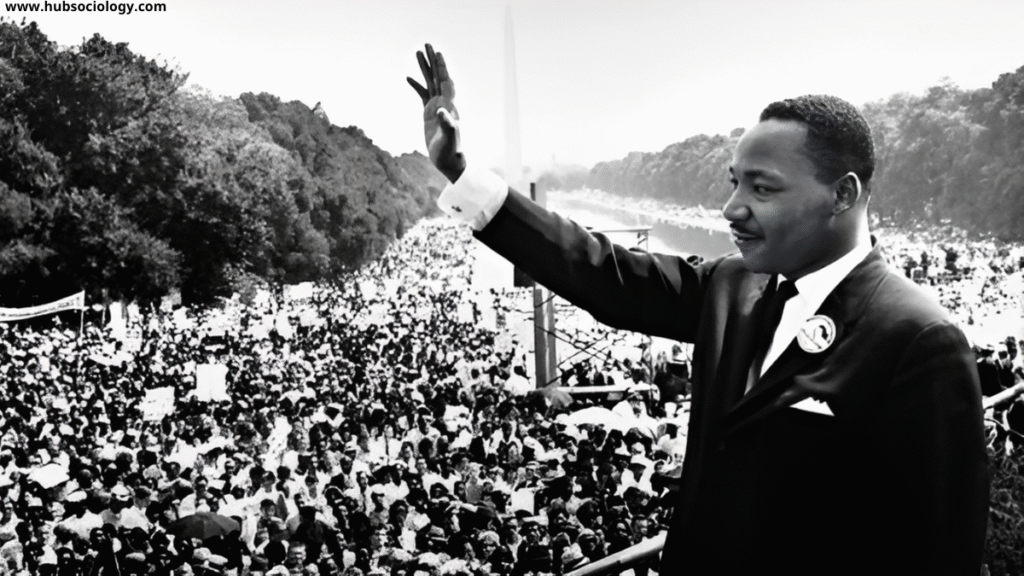Introduction on Theories of Social Movement
Groups of people working together to resist or promote social change are known as social movements. They emerge from discontent, inequality, or aspirations for justice and progress, and they play a transformative role in shaping societies. From the civil rights movement in the United States to environmental activism in the global arena, social movements highlight the interplay between human agency, structural conditions, and collective identity.
In sociology, understanding why and how social movements emerge, sustain themselves, and achieve their goals has given rise to various theories. These theories provide frameworks for analyzing the causes, strategies, and outcomes of collective action. They range from classical explanations rooted in frustration and deprivation to modern theories emphasizing resources, political opportunities, and cultural meaning.

This article explores major sociological theories of social movement and their relevance in understanding collective mobilization.
Table of Contents
1. Classical Theories of Social Movement
a) Deprivation Theory
One of the earliest approaches, deprivation theory, argues that social movements arise when people feel deprived of basic rights, opportunities, or resources. The central idea is that relative deprivation—when individuals compare their conditions with others and perceive inequality—drives collective action.
For example, labor movements in industrial societies often emerged from workers’ feelings of economic deprivation compared to factory owners. Similarly, civil rights struggles reflect political and social deprivation faced by marginalized groups.
Criticism:
- Not all deprived groups organize movements.
- Deprivation is often widespread, but movements occur only under specific conditions.
Thus, deprivation alone cannot explain the timing and organization of movements.
b) Mass Society Theory
According to the mass society idea, social movements start in big, impersonal societies where people feel helpless and alone. Movements provide a sense of belonging and identity to people disconnected from traditional institutions like family or community.

For instance, the rise of extremist movements in modern societies is sometimes explained through this lens, as individuals join to overcome alienation.
Criticism:
- It tends to pathologize social movements by linking them to psychological distress.
- It ignores rational and organized aspects of collective action.
c) Collective Behavior Theory
Introduced by sociologists like Herbert Blumer, this theory views social movements as a form of collective behavior arising in situations of social strain. Movements evolve through stages: from social unrest to popular excitement, and eventually to formal organization.
This perspective emphasizes spontaneity, crowd behavior, and emotional contagion in early stages of mobilization.
Criticism:
- It underestimates long-term planning and rationality in movements.
- It overlooks structural and political contexts that shape mobilization.
2. Resource Mobilization Theory
Emerging in the 1970s, resource mobilization theory shifted focus from grievances to the ability of groups to organize effectively. It argues that grievances are constant in societies, but social movements succeed only when they mobilize resources such as money, leadership, networks, and media access.
For example, the civil rights movement in the U.S. was not just about racial grievances—it was successful because leaders like Martin Luther King Jr., organizations like the NAACP, and financial support from allies provided crucial resources.
Key contributions:
- Movements are rational, strategic, and goal-oriented.
- Success depends on organizational strength rather than only grievances.
Criticism:
- It sometimes underestimates cultural and emotional factors.
- Overemphasis on resources may downplay grassroots spontaneity.
3. Political Process Theory
Political process theory highlights the role of broader political structures in shaping opportunities for movements. It argues that movements emerge when:
- Political opportunities open up (e.g., weakening of elites, divisions in ruling classes).
- Movements have strong organizational capacity.
- Collective identity and framing align with public consciousness.
For instance, women’s suffrage movements gained momentum during times when political structures became more inclusive, such as after major wars. Similarly, anti-colonial movements succeeded when colonial powers weakened after global conflicts.
Strengths:
- Explains why movements emerge at specific times.
- Connects movements with macro-level political changes.
Criticism:
- May understate cultural, emotional, and symbolic aspects of mobilization.
4. New Social Movement Theory
Developed mainly in Europe in the late 20th century, new social movement theory focuses on movements that go beyond economic and political grievances. These include environmental movements, feminist movements, LGBTQ+ movements, and peace activism.

Key features:
- Concern with identity, culture, and quality of life rather than only material redistribution.
- Use of symbolic action, media strategies, and decentralized networks.
- Emphasis on values such as autonomy, self-expression, and human rights.
For example, the environmental movement is less about class conflict and more about ecological values and sustainable futures.
Strengths:
- Recognizes the cultural dimension of social change.
- Highlights diversity and decentralized organization.
Criticism:
- Sometimes neglects material inequalities and structural constraints.
- Overemphasis on post-industrial societies may limit applicability in developing contexts.
5. Framing Theory
Framing theory examines how social movements construct meaning and mobilize support by framing issues in specific ways. Leaders and activists present grievances, solutions, and calls to action through frames that resonate with public values.
For instance, framing climate change as a moral responsibility to future generations has mobilized global support. Similarly, the civil rights movement framed racial equality as a constitutional and moral imperative.
Types of frames:
- Diagnostic frames: identify problems and causes.
- Prognostic frames: propose solutions.
- Motivational frames: inspire action.
Strengths:
- Highlights role of language, symbols, and narratives.
- Explains why some movements attract wider support.
Criticism:
- Sometimes seen as too idealist, ignoring structural barriers.
- Frames may not succeed without resources or opportunities.
6. Relative Deprivation and Strain Revisited
Though criticized, modern scholars revisit deprivation and strain perspectives with more nuanced explanations. Structural strain theory, for example, suggests that social movements emerge when societal structures create discontent and when conventional means of addressing grievances are blocked.
This explains why movements often arise in contexts where institutional channels of redress are weak or inaccessible. For example, authoritarian states often witness underground or radical movements because institutional strain is high.
7. Contemporary Integrative Approaches
Modern sociology often blends these theories, recognizing that no single framework fully explains social movements. For example:
- Resource mobilization provides insights into organizational strategies.
- Political process theory explains timing and opportunities.
- Framing theory highlights meaning-making and identity.
Together, they create a multidimensional understanding of why people mobilize, how movements sustain themselves, and why some succeed while others fail.
Conclusion on Theories of Social Movement
Social movements are central to sociological inquiry because they reveal the dynamic interplay between structure and agency, inequality and justice, power and resistance. From classical theories focusing on deprivation and mass society to contemporary frameworks of resource mobilization, political opportunities, and cultural framing, the study of social movements has evolved significantly.
While earlier theories tended to view movements as irrational responses to frustration, modern approaches recognize their strategic, organized, and meaningful character. Movements are not only about material redistribution but also about values, identities, and visions of a better world.
In the 21st century, global connectivity, digital media, and transnational issues like climate change and human rights have reshaped collective action. Yet, the theoretical insights from sociology continue to guide our understanding of why people come together to challenge the status quo and build more just societies.
Do you like this this Article ? You Can follow as on :-
Facebook – https://www.facebook.com/hubsociology
Whatsapp Channel – https://whatsapp.com/channel/0029Vb6D8vGKWEKpJpu5QP0O
Gmail – hubsociology@gmail.com
Topic-related questions on Theories of Social Movement
5 Marks Questions on Theories of Social Movement
- Define social movement in sociological terms.
- What is deprivation theory in relation to social movements?
- Mention two criticisms of mass society theory.
- List the three types of frames in framing theory.
- What is the main focus of new social movement theory?
10 Marks Questions on Theories of Social Movement
- Discuss the basic assumptions of resource mobilization theory.
- Explain how political opportunities influence the emergence of social movements.
- Compare collective behavior theory and resource mobilization theory.
- What role does framing play in the success of social movements? Provide examples.
- Examine the strengths and limitations of deprivation theory in explaining social movements.
15 Marks Questions on Theories of Social Movement
- Critically evaluate the evolution of theories of social movement from classical to contemporary perspectives.
- Discuss political process theory with examples and explain its significance in modern sociological analysis.
- Analyze the features of new social movement theory and explain how it differs from earlier approaches.
- “No single theory can fully explain the dynamics of social movements.” Discuss with reference to integrative approaches.
- Examine the role of identity, culture, and meaning-making in the rise of social movements with suitable examples.

1 thought on “Theories of Social Movement: A Sociological Perspective”